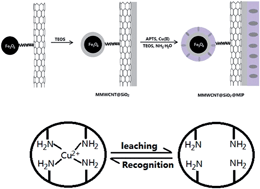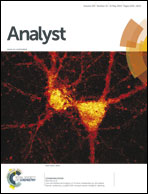Preparation of a core–shell magnetic ion-imprinted polymer via a sol–gel process for selective extraction of Cu(ii) from herbal medicines
Abstract
A novel magnetic surface ion-imprinted polymer (c-MMWCNTs-SiO2-IIP) was synthesized for the first time using magnetic CNTs/Fe3O4 composites (c-MMWCNTs) as the core, 3-ammonium propyltriethoxysilane (APTES) as the functional monomer, tetraethylorthosilicate (TEOS) as the cross-linker and Cu(II) as the template. c-MMWCNTs-SiO2-IIP was evaluated for selective extraction of Cu(II) from herbal medicines via a magnetic solid phase extraction (M-SPE) procedure. One factor affecting the separation and preconcentration of the target heavy metal was pH. Under the optimized experimental conditions, the adsorption kinetics and adsorption capacity of c-MMWCNTs-SiO2-IIP toward Cu(II) were estimated. The results indicated that the adsorption mechanism corresponds to a pseudo-second order adsorption process, with a correlation coefficient (R2) of 0.985 and a maximum adsorption capacity of 42.2 mg g−1. The relative selectivity factor (β) values of Cu(II)/Zn(II) and Cu(II)/Pb(II) were 38.5 and 34.5, respectively. c-MMWCNTs-SiO2-IIP, combined with flame atomic absorption spectrometry, was successfully applied in the extraction and detection of Cu(II) in herbal medicine, with high recoveries ranging from 95.6% to 108.4%.


 Please wait while we load your content...
Please wait while we load your content...